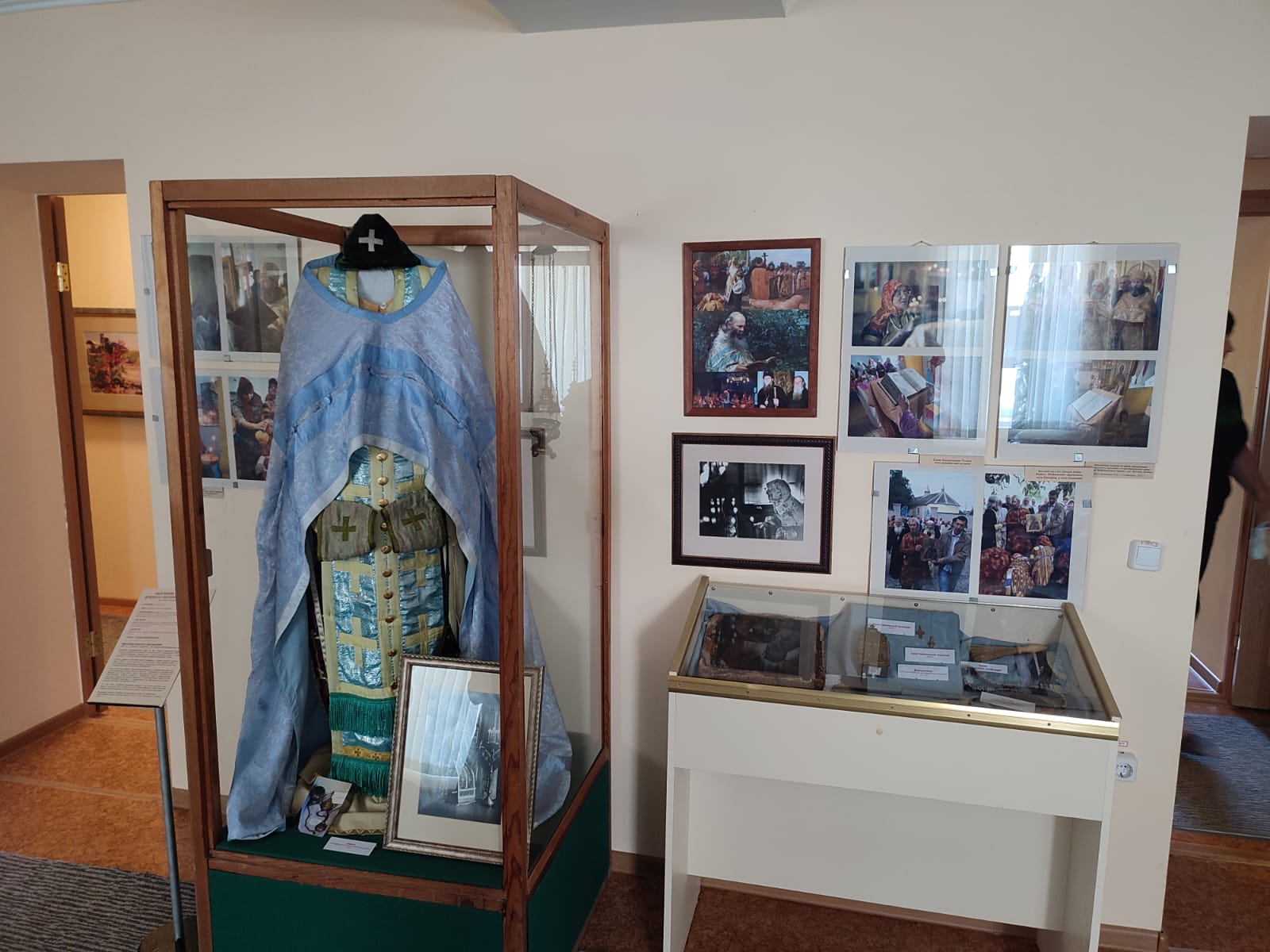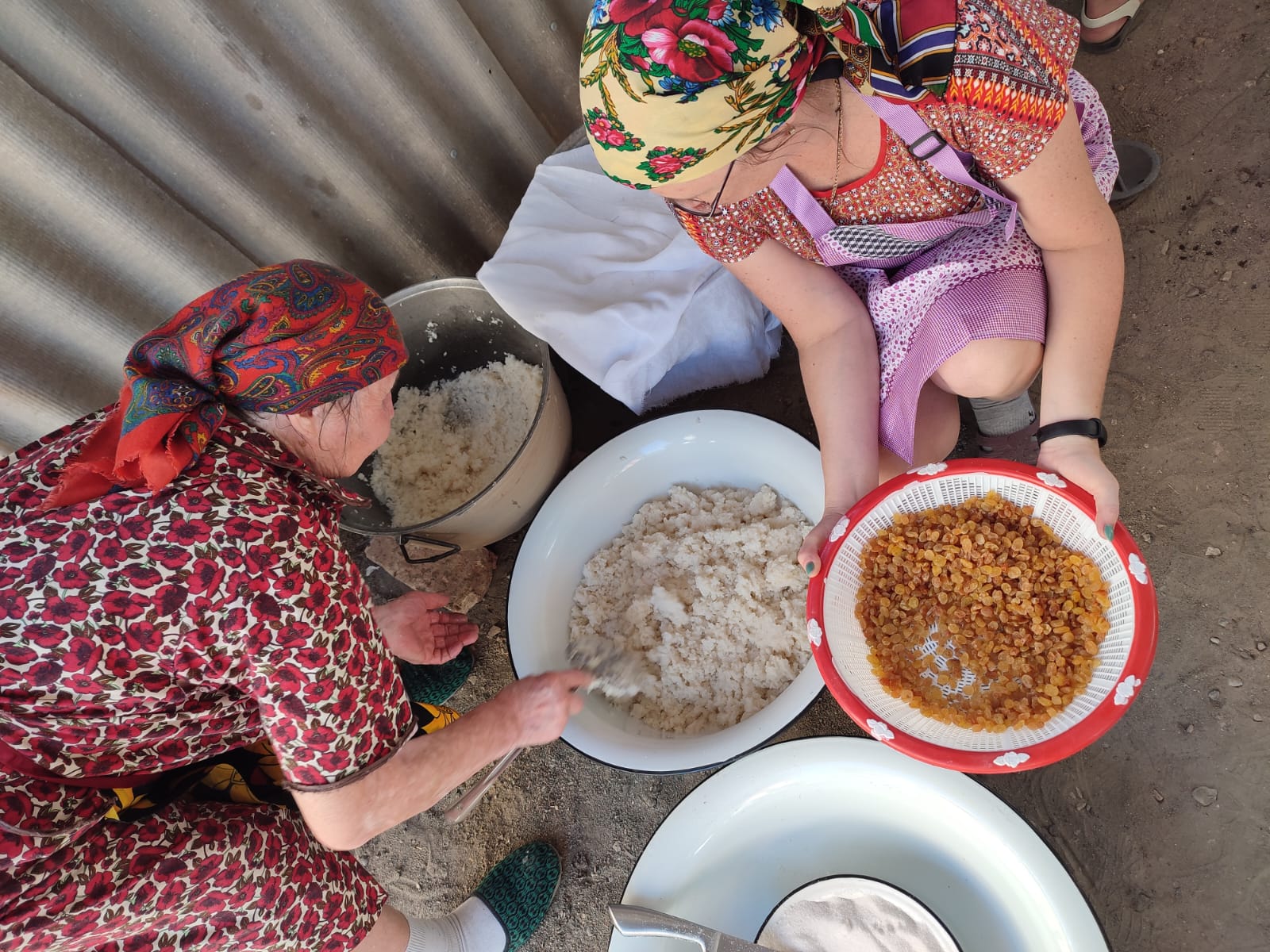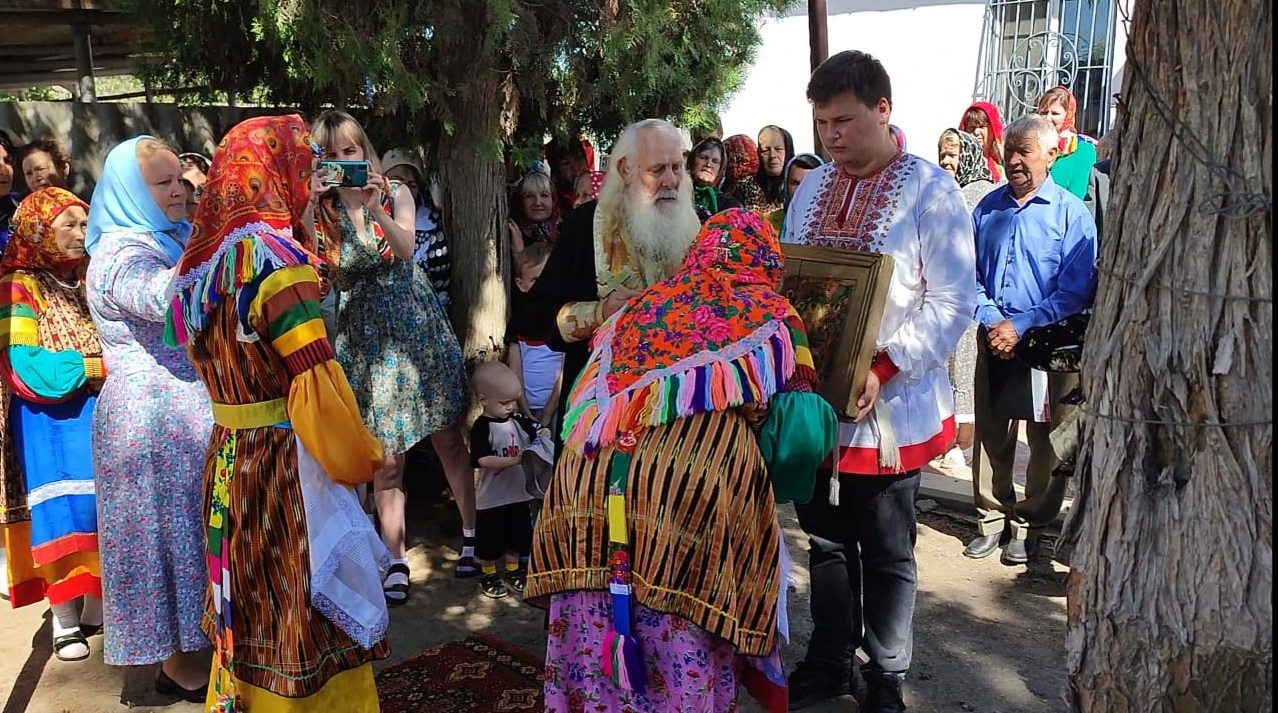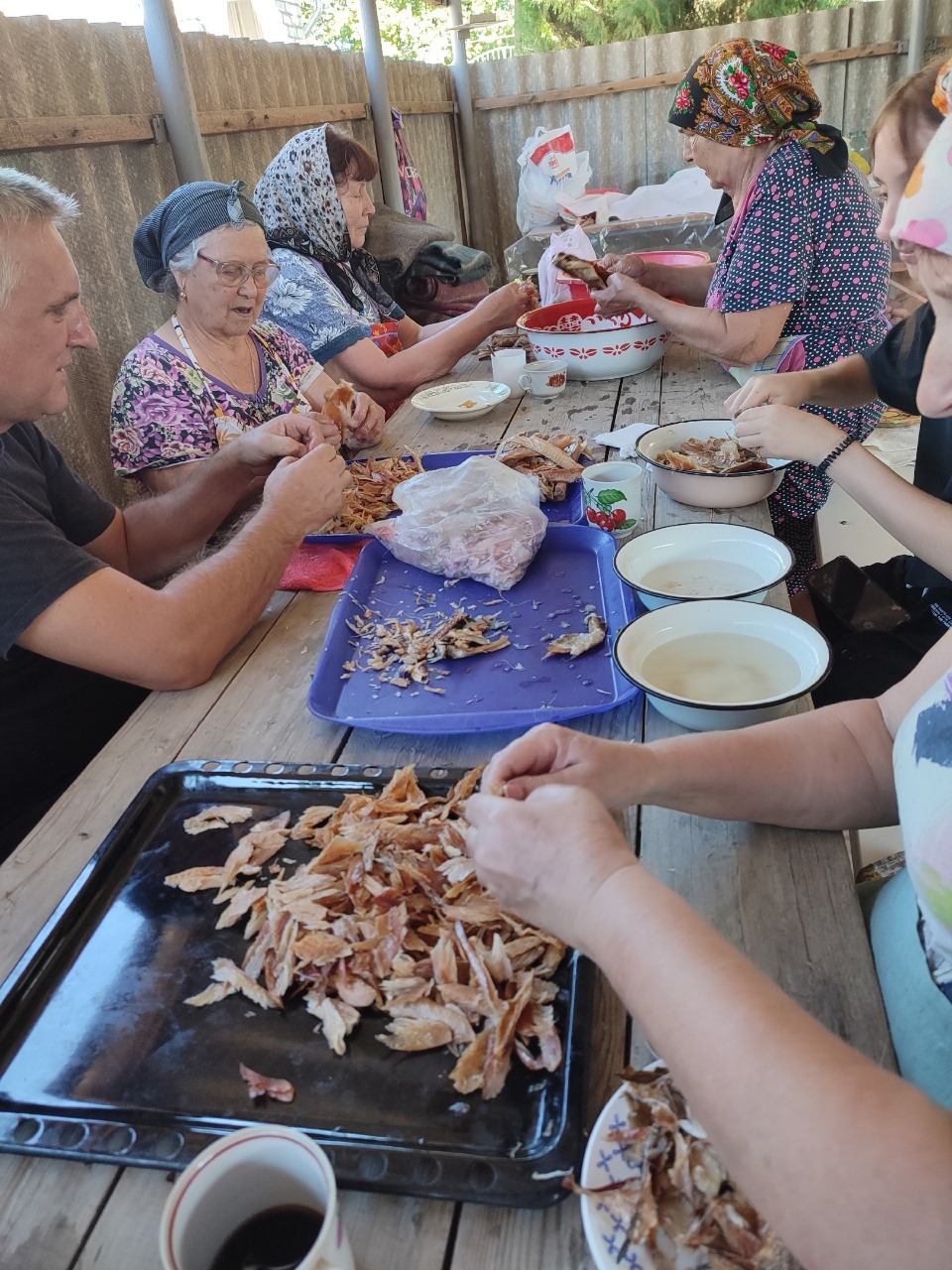Near the feast of the Dormition of the Most Holy Mother of God, an expedition took place to the Nekrasov Cossacks in the Stavropol region, consisting of the Professor of the Moscow Conservatory, Doctor of Art History N.G. Denisov and the head of the Museum of the History of Old Believers of Siberia A.N. Emelyanov.

Old Believer Nekrasov Cossacks, after their return to Russia in 1962, live in two villages of the Levokumskoe district of the Stavropol Krai: in Kumskaya Dolina settlement, where the Church of the Holy Trinity is located, and in Novokumskii settlement – here is a church dedicated to the Dormition of the Mother of God. Their traditions, way of life, particular features of worship, folklore, and other aspects of life are described in detail by ethnographers and art historians, who have been visiting them since 1963. The palm belongs to the scientist F.V. Tumilevich. For many years, dozens of folklore researchers, ethnographers, representatives of museums in Rostov-on-Don, Starocherkassk, Novocherkassk, a huge number of correspondents, and television representatives worked here. Ethnographic groups of Nekrasovites visited various cities of our country and abroad: in Belarus, Estonia, Poland, and the USA, N.G. Denisov has studied the liturgical singing culture of the Nekrasovites since 1989.

The Nekrasovites’ village was located near Lake Manyas, in the province of Balikesir in northwestern Turkey, near the city of Bandirma. At some point the Nekrasovites had five communities there. They started to return to Russia at the beginning of the twentieth century. By 1962, in the village of Kocagöl (previously the village was called Eski Kazaklar, ‘Old Cossacks’ in Turkish) there were two communities: the Holy Trinity community and the Dormition of the Most Holy Mother of God community. Upon the return to the USSR, the Nekrasovites were settled in two villages, in two parishes to which they had belonged before leaving. During the negotiations between the Cossacks and representatives of the consulate, the Soviet side promised to allow them to build their own churches. Though it was the time of Khrushchov’s persecution of religion, in 1964 the Nekrasovites erected churches at their own expense: in Novokumskii – the Church of Dormition, and in Kumskaya Dolina – the Church of the Trinity. By the way, that was a unique case, and these are the only churches built in the USSR officially in those years.
The idea for the trip emerged six months ago, when an invitation was received from the Nekrasovites, who invited us to attend their patronal feast. During the Easter celebrations, I (Alexandr Emelyanov) met by correspondence a resident of Novokumskii settlement, Gavriil Dmitrievich Belikov. I asked him for a Nekrasovite suit for my museum. Gavrila Dmitrievich agreed and invited me to the patronal feast. It was important for me to add an original female Nekrasovite outfit to my collection of Old Believer costumes of the Museum of the History of the Old Believers of Siberia. The museum is going to continue this work in future.

The first place we visited was the cemetery of Kumskaya Dolina settlement. There, among the Nekrasovite tombs, are the graves of their priests – Fr. Iliya Yelisyutikov (who was initially a priest in Turkey, and died in Russia in 1968), Fr. Theofan Banderovskiy, Fr. Yevlampiy Banderovskiy. Having prayed for the repose of the fathers, we noticed at the very edge of the cemetery several small grave mounds with small crosses. As it turned out, these are the graves of infants who died unbaptized. They, according to the Nekrasovite tradition, are buried to the side, and small crosses are placed on the graves. Returning from the cemetery, we passed by the Trinity Church, which after the death of Fr. Yevlampiy is left without a priest. From there we went to visit and talked with the old Cossack woman Paraskovia Grigorievna Yaluplina. Paraskovia Grigorievna is an amazing person! Her sister still lives in Turkey (several people did not move to either the USSR or the USA in the sixties, but stayed in Turkey). A twenty-seven-year-old young woman, Paraskovia, together with the rest of her relatives, came to the Soviet Union. Today she is already 88 years old, but she still keeps 100 birds on her farm! The doors of her house are always open – she uses folk remedies to heal the entire neighbourhood. She is reputed to be a strict faster; during fasts, she also keeps her dog on vegetarian food. And not because there is no waste for dog food, but because it’s fast. After talking with Paraskovia Grigorievna, we continued our journey to the final destination of our expedition –Novokumskii settlement.
In the evening we arrived in Novokumskii settlement, where we stayed with the daughter of the now deceased priest Fr. Kondrat Shkodrin, Yelena Kondratievna Gulina. Gavrila Dmitrievich Belikov and Yelena Kondratievna’s brother, Ilya Kondratievich, came to visit. The first thing you notice when you enter Yelena Kondratievna’s yard is the amazing cleanliness, abundance of flowers, grapes, peppers, tomatoes, cucumbers, and all kinds of vegetables. Such perfect order in all Nekrasovites’ houses! Then there were conversations with the Cossacks. You can listen to them endlessly! It was about life in Turkey, about moving to Russia, about various people and events. Although Nikolay Grigorievich Denisov has been studying the heritage of the Nekrasov Cossacks for about thirty-five years, still, every time in conversations with them he discovers something new.

On the next day we visited the museum of the Nekrasov Cossacks. In 1992, a centre of Nekrasov Cossacks and Molokans was organized in Novokumskii. In 2005, it was transformed into the Nekrasovite Museum, now a branch of the Stavropol Museum of Fine Arts. We were met by Z.A. Belaya, the director of the museum, who came from Stavropol especially for the patronal feast in Novokumskii. The exhibition presents authentic items of immigrants brought from Turkey (costume ensembles, individual objects, and accessories); household utensils and furniture, children’s toys, photographs; archival photographs of the life of Nekrasovites in Novokumskii (from 1970 to 1990-ies). A separate stand is dedicated to priests from among the Nekrasovites (several years ago, Z.A. Belaya opened a new branch building in Stavropol. Therefore, the bulk of the exhibits are now located in the centre of the region. Today in Novokumskii there are a lot of photographic materials, but not the objects themselves).
In the afternoon we went to church. At that time the preparations for the patronal feast were already in full swing around the temple. According to a long-standing tradition, some family “holds the church,” that is, prepares a festive lunch as a sign of sacrifice to God — with some request to God or making some kind of vow. The whole clan gathers for this occasion. Previously, church meals were held right in the house of such family: the harvest from the garden was completely harvested, a large tent was set up, and the entire village came for the meal throughout the whole day. Nowadays the meal is set up in the church courtyard. In addition, parishioners donate money and food for the festive meal.

Those who prepare the lunch do not participate in the service. The meal is prepared all day and all night. The process is supervised by experienced cooks who know how to properly prepare Nekrasovite dishes. After the end of the service, when the priest with the festive icon and the parishioners, singing the festive chants, approach the place of the meal, those who prepared the lunch, venerate the icon according to a special ancient rite. The women and girls of this family wear traditional festive Nekrasovite costumes. Men have long lost the custom of wearing beautiful embroidered shirts and red trousers. There are few Nekrasovite embroidered shirts left. But women and girls still flaunt their colourful attire on major holidays. The once festive clothes have now become church clothes. It is worn only for service; girls also get married in it.

After venerating the icon, the priest hands it over to the hostess of the meal, and she invites everyone to dine “with what God sent.” The icon is brought under a canopy, where tables with food are placed, and, while the hymn “Those who are protected by the cross” is being sung, the priest receives “to the cross” those who were not at the liturgy, and distributes to them the bread consecrated at the all-night vigil, poured with oil and wine. Then, in front of this icon, “Our Father” is sung and everyone sits down at the tables. The festive icon remains in the house of the family hosting the lunch, or, as the Nekrasovites put it, “the church,” for 40 days. Then the icon is returned to the church.

According to the purely Nekrasovite tradition, a certain set of dishes is prepared, which are placed on the tables in their own sequence. First, fish jelly is served (rye kvass with soaked dried fish, lemon, and dill), followed by coloured jelly (beet kvass with lemon, cucumber and other ingredients). At the same time, “game” (boiled chickens, ducks and Muscovy ducks) is placed on common plates. Then borscht is served. Then – the noodles, always homemade, kneaded from dough and cooked in “game” broth. Next they bring a very tasty dish called ‘copper fish’. The fish is first fried in oil, coated with onion and tomato mixture and then simmered with a small amount of water in the oven. The Nekrasovites say: “Cossacks cannot live without fish.” Why is the dish called ‘copper fish’? It turns out that in Turkey this fried fish was simmered in wide-bottomed oriental copper cauldrons. Hence ‘copper’. Immediately after the fish comes stewed lamb. The meal ends with mashed potatoes and beef. This dish is of “Soviet” origin, since the Cossacks did not grow potatoes in Turkey – the main emphasis was on the cultivation of legumes.
Typically, tea is not served at lunch; people are content with soft drinks. But delicacies, which usually go with tea, are served, such as “pies with porridge” and “crumpets” doused with sugar and nut paste. These foods also originate from Turkey.
Concluding the description of the dishes of Nekrasovite cuisine, I should say that they are all very tasty. It feels like everything was prepared with love, prayer, and the desire to please God and neighbour. And definitely this cuisine is significantly different from the meal we are accustomed to in Old Believer parishes in Russia and abroad.
Spiritual poems or any other chants are not sung at tables. The rector of the church, Fr. Nikifor Yaluplin congratulates everyone with the church feast, then during the lunch others can also take a word. Guests, representatives of another Nekrasovite parish from Kumskaya Dolina, always come to the meal.
The church tradition of the Nekrasov Cossacks has a lot of its own distinctive features. For example, men and women enter the church through different doors: men enter through the southern doors, and women through the western doors. Women stand in the church only in the rear (western) half of the church; they are not allowed to enter the choir. They only go to the front of the church when they bring children to communion. A woman responsible for the candles is also allowed to enter there. When the priest, after the liturgy, receives parishioners to the cross, only men and youths approach the pulpit. Then the priest goes to the back of the church, where women, maidens, and girls kiss the cross.
The peculiarities of the service of the Nekrasovites are also interesting. First of all, their singing. By the way, they don’t use the word “singing” itself. They say that singing is when songs are sung, and in the church it is “service”. This reveals the most archaic tradition among all Old Believer communities. A clear separation of the spiritual principle – prayer, from the worldly – song. Liturgical chants “serve.” So, singing, or “service,” in Nekrasovite communities is an exclusively male phenomenon – a direct pre-schism tradition. In the entire history, only one woman was honoured to sing in the choir, Yelena Kondratievna Gulina, — for her literacy and, as Fr. Nikifor Yaluplin, rector of the Dormition Church, “for her holy life.” They sing absolutely everything by ear, by heart, including the chants of the Pillar Znamenny chant, with all the fitas. Their singing “to voice” is very interesting. Their melodies are not exactly the same as those recorded in the ‘Kalashnikov’ or ‘Morozov’ books. The melodies are interesting and have only a distant resemblance to the “idiomela” songs we are used to.
Separately, it is necessary to say about the manner of singing and the voices of the singers. They sing openly and loudly. The timbre is rich. Sometimes the unison turns into two-tone on passing notes, which generally does not spoil the overall picture of the performance. But Nekrasovites never sing in thirds. They don’t hear it, since this interval was not present in the singing of Ancient Russia. Sometimes in the service there are fragments of “polyphony” – during the singing of psalms of praise and at prayer services (moleben). They have had this form of reading and singing from time immemorial. What was fought against at the Stoglav Council now looks archaic.
Another interesting point that we did not see or record at that time was the singing of kathismas during the all-night service. This time the kathismas were simply read, as is done in all other parishes. But among the Nekrasovites they are often sung. This is how N.G. Denisov describes this phenomenon in his book “Old Believer Liturgical Singing Culture”:
— The Nekrasov Cossacks are the only ones among priested Old Believers who preserve the singing of kathismas to the tune of Markel Bezborody. Because of this, they had disputes with Old Believers of other communities and met misunderstanding on the part of the clergy. Thus, in 1975, Bishop Anastasiy, who headed the Don and Caucasus diocese at that time, visited the parishes. During the service, he heard the singing of kathismas, was surprised, and even tried to prohibit their singing. However, the Cossacks showed firmness and have kept this tradition to this day.
For a more detailed acquaintance with the culture and traditions of the Nekrasovites, as well as other Old Believers from different regions, I highly recommend reading the above-mentioned book.
After the festive lunch, Gavrila Dmitrievich invited us to his place to donate a woman’s festive costume to our museum. Yelena Kondratievna also came with us to check the completeness of the costume and tell us what each part was called. Gavrila Dmitrievich, one of the most respected Cossacks in Novokumskii, not without pride, showed us his garden, where everything looked perfect. His farm is not inferior in content to Yelena Kondratyevna’s farm: dozens of chickens, ducks, and young chicks, hundreds of pepper and tomato plants, eggplants, cucumbers, grapes, raspberries, and other gifts of nature. In general, in economic terms, the Nekrasovites do not like to be inferior to each other. Everything should be no worse, or even better, than your neighbour’s! The same ideal order and cleanliness is inside the Cossack houses. Like all other Cossacks, Gavrila Dmitrievich gets up at 4 o’clock in the morning, manages the animals, cleans the house, prays the rule, and works in the garden. At the same time, he does not miss a single service — he always sings and reads in the choir. We were hoping to see the festive embroidered 19th-century shirt of Gavrila Dmitrievich himself, but now he only has a newly sewn one. He blessed his son-in-law, his granddaughter’s husband, with “that one”, and now it is kept in their family. Yelena Kondratievna chose a good set of women’s costume and carefully put together all its component parts: sleeves, robe, curtain, bundle, mutozoki and married woman’s scarf. We will definitely tell you about the names and purposes of all these items in a separate publication.
After worries with the costumes, in anticipation of our departure we said goodbye to the hospitable hosts of Novokumskii. The Cossacks asked to convey Nekrasov’s fiery greetings to their fellow countrywoman in Novosibirsk – Irina Ilyinichna Zadvornova, the wife of our rector Fr. Mikhail. As a little girl, she, being a daughter of the Nekrasovite priest Fr. Ilya Yelisyutikov, came to their historical homeland with her family and other Cossack families. As you know, everyone has only one homeland. But the Nekrasov Cossacks, due to historical reasons, have two of them — Turkey and Russia. And each of them is dear and valuable for those who, despite 254 years of living in Turkey, remained Russian Orthodox people.
And now we would like to express our deep gratitude to all those people who made this expedition possible. These are Nikolay Grigorievich Denisov, Gavrila Dmitrievich Belikov, Elena Kondratyevna Gulina – a daughter of a Nekrasovite priest and a granddaughter of a world-famous storyteller (her fairy tales were published by Tumilevich), Ilya Kondratievich Shkodrin. Christ save you!
P.S. Do you know how Nekrasovites respond to “Christ save you” after a meal? We say “to the glory of God,” but they say “for health to Holy God!” This is a centuries-old tradition.
photo: sibstarover.ru
text: Alexander Yemelyanov

